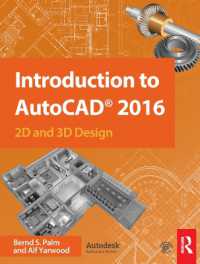Full Description
Equal accessibility to public places and services is now required by law in many countries. It is often the use of specialised technology which can provide the vision-impaired with a fuller enjoyment of all the facilities of society. In this volume the engineering and design principles and techniques used in assistive technology for blind and vision-impaired people are explained.
Features: instruction in the physiology of the human visual system and methods of measuring visual ability; explanation of many devices designed for every-day living in terms of generic electrical engineering principles; sections of practical projects and investigations which will give the reader ideas for student work and for self teaching; contributions by authors of international repute from divers fields which co-operate under the banner of assistive technology, among them: artificial vision systems; psychology, haptics, electrical engineering, design and visual physiology.
Contents
Disability and Assistive Technology Systems.- Perception, the Eye and Assistive Technology Issues.- Sight Measurement.- Haptics as a Substitute for Vision.- Mobility: An Overview.- Mobility AT: The Batcane (UltraCane).- Navigation AT: Context-aware Computing.- Accessible Global Positioning System (GPS) and Related Orientation Technologies.- Electronic Travel Aids: An Assessment.- Accessible Environments.- Accessible Bus System: A Bluetooth Application.- Accessible Information: An Overview.- Screen Readers and Screen Magnifiers.- Speech, Text and Braille Conversion Technology.- Accessing Books and Documents.- Designing Accessible Music Software for Print Impaired People.- Assistive Technology for Daily Living.- Assistive Technology for Education, Employment and Recreation.





